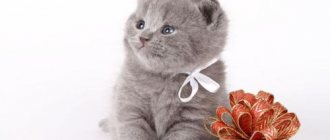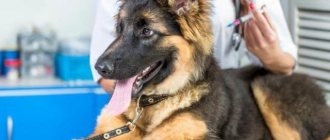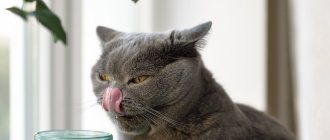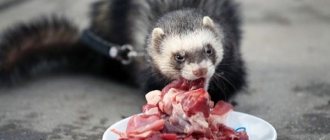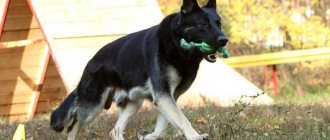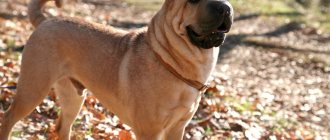Character and characteristics of British breed cats
The British give the impression of being robust, have a dense build, and are standard sized cats. The weight of an adult does not exceed 6 kg, the height at the withers is 33 cm. The muzzle has a rounded shape, unlike the Persians, it is not flattened. The distinctive features of the breed are pronounced cheeks and a fold on the tummy.
The eyes are large, expressive, round in shape, emerald, blue, amber in color. The fur coat is dense, the fur is short, “stuffed”. British cats have the same length of undercoat and guard hairs, which is why the fur is very soft, thick, plush, and raised above the skin.
The character of the natives of Foggy Albion is aristocratic, self-sufficient, but this does not mean that the animal does not need warmth, affection, attention, and will refuse fun romp and games. The British are great at entertaining themselves while people are busy with business or at work.
When everyone is at home, they like to be in society and participate in the owner’s affairs. The breed is friendly and forgiving towards children, but children should be taught to treat the animal correctly, not to force them to play when the cat doesn’t want to, and not to try to forcefully keep them close to them. They get along well with other pets: cats, dogs, rabbits.
How to stop a kitten from misbehaving
British kittens love to play pranks, but how to stop a kitten from mischief? After all, pranks are not always harmless.
You cannot hit kittens - any owner should learn this. This is a rule that must be followed, no matter how angry the furball may make you.
Of course, when a cat sharpens its claws on the sofa, rolls around on thin curtains, digs up flowers, chews shoes and breaks cups, you want to punish him for this. How to properly prevent mischief?
- If you witness preparations for a prank, clap your hands loudly - this will distract him, and he will understand that the desire to jump on the curtain is associated with an unpleasant sound.
- Sprinkle water on the place where the kitten is used to playing pranks: scratching furniture, digging up a flower, etc.
- Spray the cat himself with water when he is in the process of mischief.
- Use a spray with a citrus scent to repel and discourage the desire to misbehave.
- Accustom your kitten to the word “no”. You need to say it while looking into the cat's eyes and while he is playing around. Gradually, the pet will understand that a word pronounced with a special intonation means dissatisfaction and prohibition.
See also: Havana Brown: features of the breed, character of cats, history of origin
At what age is it better to adopt British kittens?
A good, responsible breeder will not sell the baby until it is 2.5-3 months old. By this age, the cat smoothly and painlessly weaned the children off its milk and taught them the basic rules of life in the house among people.
They know how to use a tray, know that their claws should be sharpened in a strictly designated place, and they eat “adult” food. Such kittens are affectionate, trusting, willing to make contact, inquisitive, and active. They have passed the first stage of vaccination and can now be transported to a new place of residence.
By adopting a British dog at an earlier age, the new owner is likely to encounter problems:
- categorical refusal to visit the tray for all types of needs or just one;
- distrust of people, avoidance of tactile contact;
- the desire to suck on fur products: hats, toys, blankets, robes.
- habit of attacking the legs of those passing by, strong biting, scratching in play.
Be sure to read:
Kobi cat with beautiful eyes - what kind of breed: truth or fiction, description, character, care
This happens because the kitten has not gone through the necessary stages of growing up next to an adult, and some instincts remain unsatisfied.
A Briton's first day at home: what should already be prepared?
The moment has come when a man, fascinated by the British man’s charm, finally decides to become his master. What should be in the house before a furry miracle is brought there?
- Sleeping area. This option will most likely surprise many, because most often dog owners think about this issue. However, in the maintenance of the British, the place of rest is also of no small importance. The fact is that this pet is quite independent and has a positive attitude towards the idea of retiring in a secluded corner from time to time. A special bed or even a house can be a great gift for an animal.
- Tray. Considering the cat's character mentioned above, it is advisable to purchase a closed type of toilet. It is important to ensure that it is high enough and spacious enough. If you choose an open tray, you need to take a closer look at its edges - those concave inward prevent the filler from spilling.
- A bowl. It is curious that experts recommend using dishes with different characteristics for food and water. So, for food it is desirable to have tall dishes with a wide bottom made of metal, and for water - made of ceramics.
- Scratching post. Despite the fact that the British cat is quite well-mannered, he cannot escape the need to sharpen his claws. And it is best to do this with the help of a stable structure of medium height - there is less risk that it will tip over and injure the animal.
- Carrier – all cat owners use it from time to time. The main requirements for such an acquisition are strength and simultaneous lightness, spaciousness, moisture resistance, ventilation. Particular attention should be paid to the door - it must close well.
- Combs. Anyone who has been caring for these pets for a long time knows that there is no way to do without these items! A rubber oval comb that removes static electricity and a massage brush are a must.
- Dry shampoos, balms, sprays are ideal products for caring for a fur coat without the use of water treatments. It is worth familiarizing yourself with the composition: extracts of lemon, rosemary, sage, chamomile, yarrow, nettle and rose cleanse well.
- Tinting powder - some owners recommend using it when you want to improve the color of your coat.
- A special liquid for cleaning the ears, as well as eye hygiene products and an oral spray will make caring for your pet easier.
Care and maintenance of the British cat breed
The British are unpretentious in their upkeep and feel great in a small apartment or a spacious country cottage. The pet does not require special care. By nature, ticklers have good health and live 15-18 years. The owner’s task is to organize the cat a proper lifestyle, then he will be able to avoid many problems and enjoy the company of his pet for many years.
What should you buy for a British kitten?
Before you bring a funny baby into your home, you need to prepare for the arrival of a new family member and purchase:
- toilet tray, spatula, filler (this can be pressed sawdust, silica gel, granules or sand with a fragrance, which attracts cats and helps them quickly remember a new place to relieve themselves.);
- bowls for food, water (plastic or stainless steel).
- ready-made food, if the owners choose this type of food (it is better to find out from the breeder in advance what the kittens ate and not change the diet too quickly).
- comb, shampoo for kittens, flea preventative (collar, spray).
- scratching post;
- toys (balls, sticks with feathers) or make them yourself. A paper ball or ping-pong ball will cause no less a surge of joy in a small pet.
Additionally, you can buy a cat bed, a house or a whole complex, cats like to climb on it and watch what is happening from above. It should be located away from drafts and heating devices.
How to properly care for the fur of a British cat
During the shedding season, it should be brushed daily: it will look beautiful and there will be less hair in the house. The rest of the time, it is enough to comb once every 5-7 days. It is better to avoid frequent bathing by performing bathing procedures when your pet is heavily soiled. Human shampoo, even hypoallergenic baby shampoo, cannot be used.
It is necessary to use a special product from a pet store, selected taking into account the type of coat and color of the pet. Flea prevention needs to be carried out periodically. Animals that have access to the street, from the end of April to October, are treated with compounds against ticks - carriers of brucellosis, rabies and other dangerous diseases.
How and what to feed?
In order for a kitten to grow up cheerful, playful, healthy, and develop properly, it must be properly fed from the first days. The diet should be balanced. There are two options for feeding at home - use regular food or ready-made store-bought food. Ready-made food has the following advantages:
- when creating it, all the necessary components needed to saturate the kitten’s body were taken into account;
- you don’t have to think about preparing cat food – you put it in a bowl and that’s it.
Dry and wet food is used for feeding. It is better to buy special products of the same brand, focusing on the age of the pet. Information about who the food is intended for is indicated on the packaging. When feeding solid store-bought food, make sure you have clean, fresh water at the ready. If you decide to feed your fluffy with natural products, you will have to prepare food for him separately. Food from the master's table is not suitable.
If a kitten has recently been born, it is natural for it to feed on its mother's milk. If he is taken away from the cat too early, you need to use a milk replacer, which can be found in veterinary pharmacies. From the age of one and a half months, the baby is transferred to goat or cow milk, diluted with boiled water to reduce fat content. After 30 days of life, in addition to milk, lean meat in the form of minced meat becomes part of the diet. The purr is fed cottage cheese with a small percentage of fat, and milk porridge from cereals.
From the age of two months, the pet is offered store-bought canned food for kittens, boiled lean meat, and egg yolk. After another month, the little four-legged friend is introduced to fish food. All bones are removed from sea fish before consumption. And also from 3 months the kitten is offered boiled vegetables.
If before this age he was fed 5-6 times a day, now four meals a day are enough. At 5 months, the kitten is ready to eat all the foods that cats usually eat. Spices and salt should not be added to cat dishes.
From six months of age, British cats are offered regular cat food with a significant content of lean meat, both boiled and raw. To give raw meat and fish to your pet, they are first frozen in the freezer and scalded with boiling water before eating, which avoids infection with parasites. The British have no longer been given porridge and milk for six months. This food is poorly digested in the body of an older cat, which leads to abdominal pain and abnormal bowel movements.
From one year onwards, food is provided depending on the preferences of a particular pet. And if the cat is neutered, you cannot give him fish and some other foods. In this case, it is better to consult a specialist about the intricacies of the diet, as well as about the menu for older cats. From the age of eight, these animals are considered elderly. Their diet is different from the “youth”. The tailed inhabitant of the apartment should not be fed chicken or turkey skins or paws.
It is advisable to supplement the meat with rice, buckwheat or pearl barley. Fermented milk products remain part of the diet. You can feed an adult pet 2-3 times a day.
Toilet training the British
An important point in teaching a cat to the rules of hygiene is choosing the right tray.
Three types are common today:
- lattice (used without filler);
- with sides (for filling);
- Closed toilet-house.
Be sure to read:
How long do Scottish fold cats live: what affects them, vulnerabilities, how to prolong life
The size of the “pot” should correspond to the size of the animal and be comfortable for it. Some owners teach cats to use the toilet; with the right approach and patience, this is possible.
The place for the tray is chosen to be calm and secluded. In the first days, you should bring the kitten to the litter box more often, especially after sleeping or eating, reminding him of the location of the toilet, he will quickly remember. Refusal to give up the tray can be caused by the acrid smell of plastic, inconvenience, precarious position, or type of filler.
If you find a pile in another place, you cannot hit the baby or scream, he will get scared, hide and shit under the bathtub or sofa. It is better to move the find into the tray, and put the kitten in the toilet, using his paw to scoop up the litter. Like a human child, it can be difficult for him to endure, but he will learn.
Hygiene issue
Proper keeping of an animal is unthinkable without hygiene:
- Eye care is a big thing for Brits. Even a healthy cat faces the problem of discharge from the eyes. Normally, they are insignificant in adults. This phenomenon affects kittens a little more, but it does not mean at all that the cat is allergic. The owner is simply required to remove the discharge. A regular napkin soaked in water and cotton swabs will come in handy. You can also find special lotions on sale for both regular and heavy lacrimation. It is important to wash your hands thoroughly before handling your cat's eyes! The direction of wiping is from the outer corner to the inner. It is worth monitoring the condition of your eyes at least once a day. Otherwise, dark discharge will begin to accumulate quite quickly and disturb the pet.
- A big misconception of many owners is to think that caring for a cat’s claws should be limited to purchasing a scratching post. It is certainly important, but it is also worth doing a haircut periodically. On average, it is worth straightening the claws on the front paws once every half month, and on the hind paws - once a month. The hair should be cut carefully and no more than half the length.
- The ears should be examined approximately once every six months. If contaminants are found, you should carefully remove them with a cotton swab, previously placed in warm boiled water. Some breeders also advise periodically lubricating the exposed part of the ear with a small amount of cosmetic cream or Vaseline.
- You need to check your mouth every day. Cats that go outside have the opportunity to chew what they need to prevent tartar formation, such as grass or a twig. If a pet constantly or too often sits at home, naturally, he is deprived of such an opportunity. It’s easier for those cats who eat dry food - their texture perfectly cleans their teeth. But, of course, feeding such food should be done on a regular basis. If the cat is a homebody who eats natural food, its owner will have to pay attention to special products for cleaning the oral cavity.
British cat nutrition
The British have a high appetite, so there is a high risk of obesity, leading to diseases of the heart, blood vessels, and joints. You should feed them well, but in moderation, without succumbing to the provocations of hungry eyes and begging for treats.
Feeding a British cat with natural products
The basis of a natural diet is lean meats: beef, chicken, offal. Lean sea fish should be boiled and separated from the bones; river fish should not be given.
Buckwheat, oatmeal, rice are steamed with broth, water and given 2-3 times a week. Vegetables include carrots, cucumber, broccoli, and beets. Fermented milk products are useful, 1-2 eggs in 7 of them will give the coat a beautiful shine
Dry food for British cats
High-quality food is an excellent option for those who do not have the time or desire to bother with cooking. Wet stews, pates, premium and higher dry granules have high nutritional value and provide the body with the necessary set of valuable nutrients.
The special dryer for the British has a special biscuit shape, preventing the food from being swallowed whole. Chewing them cleans teeth from stone and plaque, puts stress on the chewing muscles, and is a prevention of periodontal disease, leading to tooth loss.
Feeding
Feeding is an important part of caring for any cat. What to choose, dry food or natural food?
Feeding dry food
Attention!
Cats, in principle, of any breed, are prohibited from fasting for more than 2-3 days. It is important to take this fact into account when owners leave and leave animals alone.
- If dry food has been chosen for feeding, then it is strictly forbidden to mix food from different manufacturers.
- If you want to diversify your diet with wet food, then this is not advisable; in extreme cases, you can mix it, but do this very rarely and take “wet” and dry food from the same manufacturer.
- The daily norm is 10% of body weight. This is for kittens. And for adult cats – 5% of body weight.
- You cannot give dry food as a treat if you are feeding the kitten “natural” and vice versa.
Features of feeding with natural food
Certain rules must be followed if you plan to feed the “British” natural food.
- Both kittens and adult British cats should not be given the following foods: pork, fatty lamb, salty foods, smoked, sweet, spiced foods, onions, and eggplants are completely poisonous for cats.
- All kinds of bones, chicken necks, heads, legs can be given to cats, but only under the personal supervision of the owner.
- These cats should not be given fish often. If given, it should be given to adult cats, not kittens, and no more than once every 2 weeks.
- If you feed your cat or kitten natural food, be sure to give it vitamins. It is better to consult a veterinarian about which vitamins to take.
- You can give raw or boiled liver, but very carefully. The liver has a laxative effect.
- Do not confuse the words “natural food” and “the food that people eat.” People eat a lot of harmful things, especially harmful for cats.
- Natural food should only be stored in the freezer, ideally divided into single portions. Of course, you cannot give a cat of any breed unfrozen natural food.
- 1 serving of natural food should be in the following proportions: about 70% meat, about 25% vegetables, 5% porridge.
Estrus and mating features of British cats
At 7-9 months, the young lady will first show interest in the opposite sex. An earlier date is possible if there is an uncastrated cat nearby, which stimulates puberty with its smell. The first heat is usually shorter than subsequent ones (4-5 days, instead of 6-10).
Symptoms:
- The cat is restless;
- Requires attention, seeks affection;
- Rubbing against objects, legs;
- Purrs in a special way.
You can admit a cat no earlier than the third heat, before that the body has not yet fully formed and become stronger. Carrying kittens, giving birth, and feeding takes a lot of energy and can undermine the health of the animal.
Sterilization of a British cat
Owners who do not plan to stop breeding the breed, who do not want to endure the delights of their pet’s heat, can sterilize it at any age, starting from 7-8 months. The operation is performed under general anesthesia and may include removal of only the ovaries or the ovaries with the uterus; in each case, the issue is discussed with a veterinarian.
Be sure to read:
How to care for a British kitten: feeding, education, mating features, when to vaccinate
A day before the operation, the animal is limited in food, the sterilization itself lasts about an hour, after which the “patient” can be taken home. The veterinarian will give instructions on proper dressing, treatment of sutures, and prescribe a course of antibiotics to prevent inflammation and complications. A person who does not have the skills to cope with rehabilitation care can only strictly follow the doctor’s instructions.
Cats that have undergone castration are less aggressive, are not prone to running away from home, do not mark in the apartment, and live longer. The optimal age is 6-9 months. Surgery at a more mature age does not always improve a male’s behavior; many habits remain.
Let's take care of safety
Everyone understands that animals are extremely inquisitive natures, which is why, in fact, they not only often get into trouble and get injured, but also cause their owner a lot of trouble. In order not to be a regular client at the veterinarian, follow these rules in everyday life:
- Store all medications, household chemicals and other hazardous liquids in a locked place. Preferably with a key or a lock.
- Are you going to the bathroom? Be sure to close the bathroom so that the kitten does not accidentally get in there.
- Baby's toys should be locked. While playing with them on his own, he may accidentally swallow them, chew them, or hit some object while playing. Remember that grooming is not only about playing and feeding, but also about taking care of your Briton.
- Close doors to utility rooms or garages.
Vaccination (vaccinations) of the British
Vaccination is necessary for absolutely all cats, including those not walking outside. A person can bring the pathogen on shoes or clothes. The first vaccination is given at 8-9 weeks, preceded by anthelmintic treatment. The next vaccine will be given in a month.
It will protect your pet from:
- Cat distemper (Panleukopenia);
- Calcevirosis;
- Chlamydia;
- Rhinotracheitis.
Rabies is vaccinated separately. You need to get an animal passport, where vaccine tags will be pasted, confirmed by the clinic’s stamp indicating the date. Having such a document allows you to transport an animal across the country and abroad, and helps you remember about the next vaccination dates. An adult animal is vaccinated annually.
Diseases of British cats and their symptoms
British cats are naturally in good health, but are prone to endocrine disorders; if a pet loses weight with a normal appetite, it should be seen by a veterinarian. The gastrointestinal tract of representatives of the breed is sensitive to low-quality food, and they themselves are food lovers.
The owner needs to monitor the quality of food and its quantity, avoiding overfeeding. Excess weight can become a trigger for the development of diabetes.
The breed's problem is claw fungus and cystitis. You need to give your pet a manicure on time, give him a scratching post and monitor the color of his urine. Another British disease is hypertrophic cardiomyopathy (HCM), which is caused by a large heart. At 12, you should undergo an ultrasound examination and repeat the procedure every 2 years.
British cats are popular today among cat lovers; it is impossible to look at the cute, plush fat cats with big cheeks indifferently. With proper care, the purr will live next to its owner for many years and will bring joy with its presence. What nuances of their content have you encountered?
Basics of proper education
The sequence of proper education of representatives of the breed:
- First of all, a positive goal of education must be formed. That is, the baby must understand that he is loved and appreciated.
- There is nothing more effective than affection in raising kittens. Even if your pet has done something wrong, you should not scream or yell. Moreover, show physical violence.
- The British are famous for their intelligence and intelligence. It is enough to show them the tray once and tell them what to do there, and they immediately grab it.
Reference!
Of course, parenting can clash with reality. For example, if the owner has a large apartment, he may simply get lost in it.
It should be remembered that the first days in a new home for a pet are associated with enormous stress. Therefore, there is no need to demand much from him.
